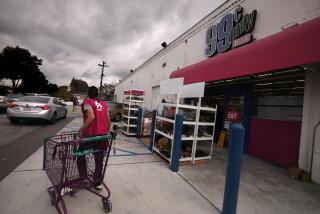The joys of shopping in Buenos Aires
Buenos Aires
Not only am I not a shopper, I am so not a shopper. But on my recent trip to Buenos Aires, it just made so much sense.
There were three main draws: first, price. I quickly realized that I would lose money by not shopping here, what with trendy suede sneakers for $20, dress shirts and casual pants for less than $25 and antiques, housewares and fashions by young local designers for a fraction of what they would be stateside.
Chalk it up to the exchange rate. The Argentine peso used to be pegged one to one with the U.S. dollar, but the peso dropped after Argentina’s economic collapse of 2001. Although the peso has risen (about 3 pesos to the dollar compared with 4), local prices have stayed constant, meaning that Buenos Aires remains a value for Americans.
Meals in Argentina’s signature parrilla (grill) restaurants top out at about $9, including wine. Artful, midrange hotels run around $80 per night, a taxi across town costs about $4, and the subway costs about 23 cents a ride.
Second, Argentines dress to the nines. Wear shorts and sneakers and you’re sure to look, well, ridiculous. So, I had to get busy.
Third, Buenos Aires has unique ways to shop. I quickly grew weary of the better-known shopping districts. The pedestrian street Calle Florida was a jostling experience with tourists being given handbills every few steps. Nearby, I loved the Beaux Arts design, handsome murals and high-end clientele of the Galerías Pacífico mall, but I was less enthusiastic about the number of boutiques you could just as easily find in any big U.S. city or even at the outlet mall in Cabazon: Christian Dior, Cacharel, Levi’s, Tommy Hilfiger, Polo, Sony and Timberland among them.
Instead, I focused on three neighborhoods that offered a bit of local culture along with the shopping: a giant street market, a stylish design center and bars that were transformed into bazaars during the day. Go on a Sunday to see them all in full swing.
The result: Buenos Aires turned out to be something like a museum with benefits, and my shopping friends found it irresistible.
San Telmo
San Telmo calls itself the birthplace of Buenos Aires and remains its most prepossessing neighborhood; squint and you might think you’re in Rome. Many of the grand buildings began as aristocratic homes during Argentina’s colonial period, but a late 19th century yellow fever epidemic led to an exodus, and San Telmo became largely tenement housing.Many decades later, the area was rediscovered and became a hotbed of arts and antiques; tourist pamphlets list more than 500 merchants. The neighborhood booms on Sundays during the Feria de San Pedro Telmo street fair; the main street, Defensa, is closed to vehicles. Purveyors, peddlers and performers fill the squares, parks and cobblestone streets. Accordion and string music — and somehow they’ve wheeled out a piano — wafts through the air to the strains of Carlos Gardel, who is to tango what Elvis is to rock ‘n’ roll. You won’t have to wander far to find an impromptu tango show.
The center of the street fair is Plaza Dorrego. Look for seltzer bottles of colored glass, porcelain urns, license plates, store signage and books, as well as more recent brass jugs and scales, stickers and toy cars.
San Telmo is worth a stop the rest of the week too. Galeria El Solar de French is an antiques mall on the site of the home of a decorated 19th century general. La Candelaria is a little warren of shops selling antique chandeliers and lampshades, posters and sewing machines, tableware and jewelry. Then there’s the Guevara Gallery, which displays Deco furniture and lighting.
The Mercado San Telmo (established 1987) is stocked with bric-a-brac (trading cards, blankets, advertising signage, plus a produce market) but is atmospheric nonetheless, beneath a tall ceiling of aged wrought iron and corrugated tin.
Nearby, Balthazar is a men’s clothing boutique so chichi that you have to ring a doorbell to enter (no bargains here).
Recoleta
Recoleta Cemetery is the city’s only agreed-upon tourist attraction — its Père-Lachaise, its Petra, its pyramids — final resting place of Argentina’s elite, including presidents, generals, academics, Eva Perón and the father of tennis star Guillermo Vilas. If it’s tasteless to call a cemetery dazzling, then I’m a heathen. Proportioned like a miniature village or an oversize train set, stately Greco-Roman crypts line narrow walkways. It’s a maxim among porteños (as city residents are called) that it’s less expensive to live your entire life in Buenos Aires than to be buried in Recoleta.Nearly adjacent, Buenos Aires Design offers two levels of shopping in its Mall de Decoración, showing off styles for use in this life: furniture and housewares from Argentina and abroad. Nothing here was particularly cheap, but the displays are often impressive and the goods unique.
Morph, a rangey, high-ceilinged space, sells wine caddies, placemats, throws and trays all made of leather and cowhide from the Pampas; blankets and tapestries in rugged, geometric patterns recall the gauchos.
Upstairs, Puro Diseño specializes in housewares and accessories by Argentine designers: leather handbags and clutches, cushion covers of suede and leather, leather-bound sketchbooks and giant plastic screws that you can use as hooks in the bathroom.
Dogma represents 300 local artists in media from oil painting to glass art; I was particularly taken with the glass trays and plates by Romina Cohen, which seemed inspired by Miró.
On Saturdays and Sundays, an art fair takes place in the park between the cemetery and the design mall. Stalls along narrow paths sell more crafts than art: ceramic cups, wood carvings, silver jewelry, woolen clothing and bombillas, gourds for drinking Argentina’s national drink, yerba mate (bitter green tea sipped through a metal straw). Snack on cotton candy, fresh-squeezed juice and candied apples rolled in popcorn, or lounge on the grassy lawns, where you might catch a guitar singer or puppet show.
Palermo
Buenos Aires is nothing if not a party town. It keeps Spanish hours: Arrive at a restaurant for dinner at 10 p.m. and you’ll be all alone for the first hour or more; 1 a.m. is still early for bars and nightclubs; and it’s not unusual to return home after sunrise.The Palermo district is party central, with bars, nightclubs and late-night restaurants in the neighborhoods of Las Cañitas, Palermo Soho and Palermo Viejo. Some bars around Plaza Serrano in Palermo Viejo have found a way to make money even in the afternoon. About half a dozen of them become clothing bazaars when the sun is out.
Tazz is typical; Doors videos with Jim Morrison play in the background, and pool tables double as display tables for necklaces and handbags. The bar area is filled with racks of trendy T-shirts, jackets, camisoles and dresses, many by young designers who work in the neighborhood.
There’s a similar scene beneath the mirrored balls at Las Brugas, and the work of young designers fills every narrow nook of Bar Macondo.
A short walk away are more established boutiques: Rapsodia is the jeans brand of choice among fashion-conscious Argentines, Prune is noted for leather bags, and my Argentine-born female friend swears by Caro Cuore for lingerie (although she says sizes run small).
With all the money I spent, I felt as if I had single-handedly rescued the Argentine economy. Not bad for $150. More than that, I felt like I had left much richer than when I arrived. Maybe there is such a thing as retail therapy after all.
More shopping
Patio Bullrich: It’s a tony shopping mall in Recoleta, with about 70 shops and a well-respected food court, in a onetime cattle auction hall.Avenida Santa Fe in Palermo and Recoleta: It’s worth a stroll for bargain-priced clothing and footwear, from formal to casual.
Alto Palermo on Avenida Santa Fe: This contemporary mall (built in 1990) won awards for its architecture. It has some of the same shops as Galerías Pacífico but fewer tourists.
More to Read
Sign up for The Wild
We’ll help you find the best places to hike, bike and run, as well as the perfect silent spots for meditation and yoga.
You may occasionally receive promotional content from the Los Angeles Times.






